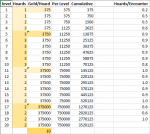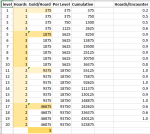James Gasik
We don't talk about Pun-Pun
Oh no, I'm not asking for a realistic economy, I'm simply pointing out that what the game has doesn't even make sense. A big part of any RPG experience is immersion, being able to accept the fantasy world and imagine yourself as a character in an interactive story. But when your DM says "hey, I think I'm going to let people buy uncommon magic items for 500 gp", and you pass because you're scrimping and saving for your plate armor...and then the Cleric shows up wearing Adamantine Plate, well, there's no logic to that at all.
I feel that any guidelines for treasure have to take into account at what point should players be able to buy a given item. And further, that there should be milestone items for everybody, not just the heavy armor wearers. Way back in the distant past, when I first started playing this game, there were several such milestones, and reasons to want gold that had nothing to do with buying magic items. In addition to the best gear, you wanted a horse. Maybe you were saving up for that keep you wanted to build/refurbish/outright steal. A standing army doesn't feed itself, you know.
Right now, treasure guidelines in 5e have no basis in anything, because there is little use for money. The DM has to make money important in his game, with no real guidelines other than supporting one's lifestyle. Which is trivial after awhile. My highest level 5e character ended up sitting on 17,000 gp because there was literally nothing to do with it that mattered.
Gold needs to matter, there need to be factions to ingratiate yourself with, officials to bribe, churches to tithe to, NPC's to impress, titles to be won, boons to be acquired, training from powerful wizards and mighty warriors, renown to be earned, and ventures to invest in.
And not as "taxes" to divest you of your money (that would be a realistic economy, lol), but actual milestones to achieve. A lot of people say that 3e's big failure was that it made money another experience track. I don't think that's a wrong thing, but rather than make it about magic items, there are a lot of non-magical benefits that can be gleaned from large amounts of cash, and I think it's a damned shame that very little thought was put into this sort of thing in the game so far.
I feel that any guidelines for treasure have to take into account at what point should players be able to buy a given item. And further, that there should be milestone items for everybody, not just the heavy armor wearers. Way back in the distant past, when I first started playing this game, there were several such milestones, and reasons to want gold that had nothing to do with buying magic items. In addition to the best gear, you wanted a horse. Maybe you were saving up for that keep you wanted to build/refurbish/outright steal. A standing army doesn't feed itself, you know.
Right now, treasure guidelines in 5e have no basis in anything, because there is little use for money. The DM has to make money important in his game, with no real guidelines other than supporting one's lifestyle. Which is trivial after awhile. My highest level 5e character ended up sitting on 17,000 gp because there was literally nothing to do with it that mattered.
Gold needs to matter, there need to be factions to ingratiate yourself with, officials to bribe, churches to tithe to, NPC's to impress, titles to be won, boons to be acquired, training from powerful wizards and mighty warriors, renown to be earned, and ventures to invest in.
And not as "taxes" to divest you of your money (that would be a realistic economy, lol), but actual milestones to achieve. A lot of people say that 3e's big failure was that it made money another experience track. I don't think that's a wrong thing, but rather than make it about magic items, there are a lot of non-magical benefits that can be gleaned from large amounts of cash, and I think it's a damned shame that very little thought was put into this sort of thing in the game so far.


